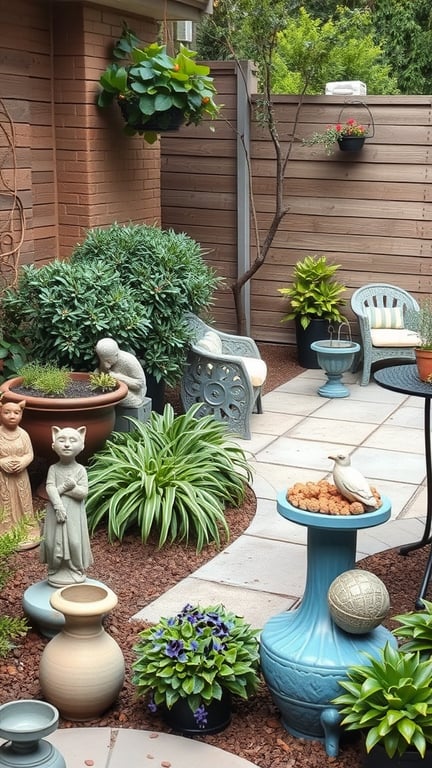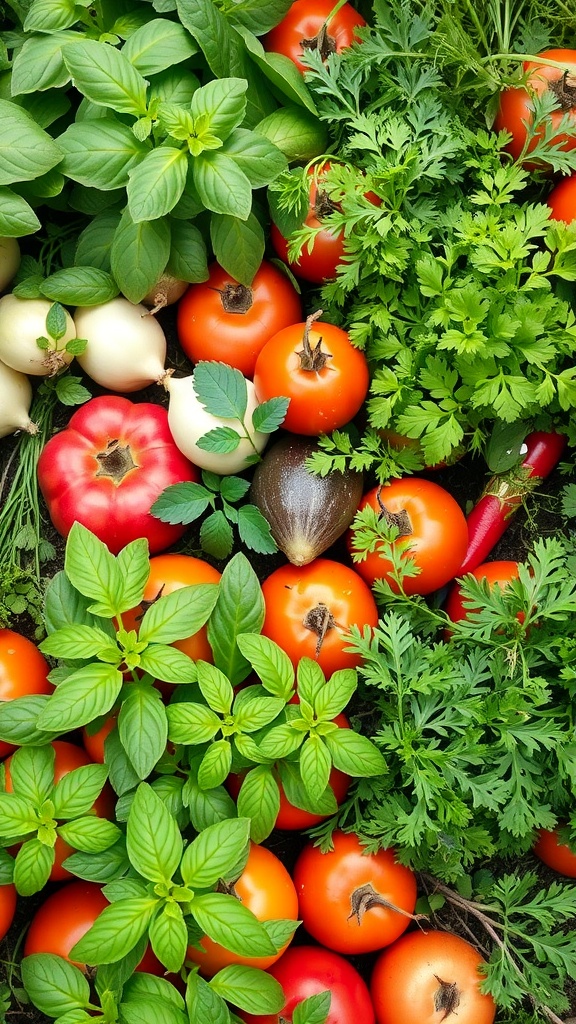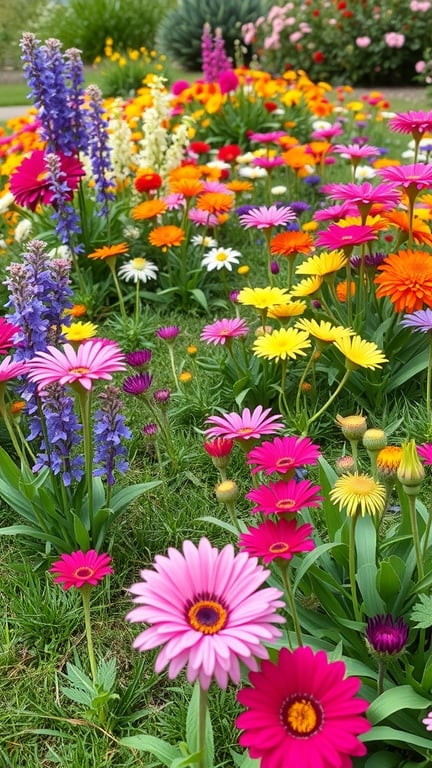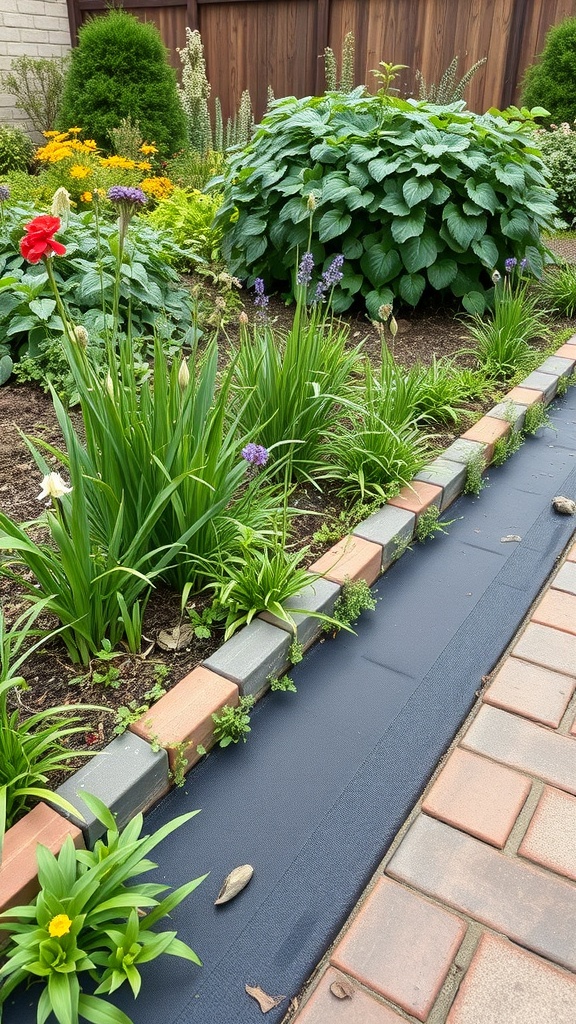27+ Stunning Shade Garden Ideas You’ll Love
Creating a shade garden can turn a dimly lit area into a thriving oasis filled with unique plants. Whether you’re dealing with towering trees casting shadows or simply want to add some greenery under a porch, there are plenty of beautiful options that flourish without direct sunlight. With these tips and plant suggestions, you’ll find joy in cultivating a lush, serene escape right in your backyard.
Layering Heights for Visual Interest
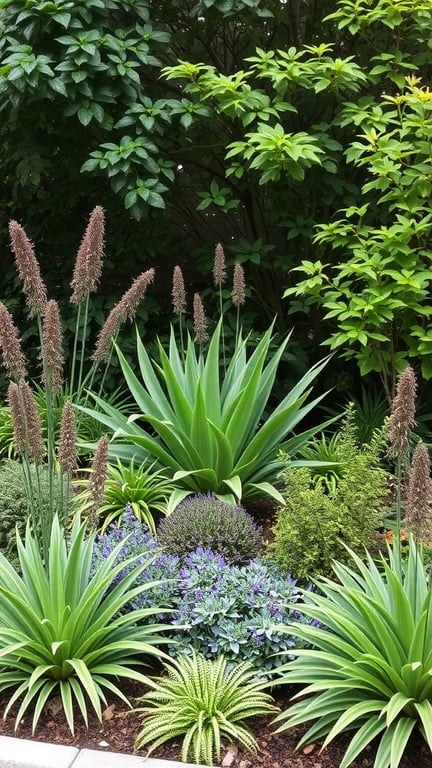
Creating a shade garden can be a delightful experience, especially when you think about layering heights. The image showcases a beautiful arrangement of plants that vary in size and texture, making the garden visually appealing.
In the foreground, you can see tall, spiky plants that draw the eye upward. These plants add height and create a striking focal point. Surrounding them are medium-sized plants with vibrant foliage, which provide a lovely contrast. The lower-growing plants, with their soft textures and colors, fill in the space beautifully.
Mixing different heights not only adds depth but also encourages a sense of movement in the garden. The combination of tall, medium, and low plants creates a dynamic look that keeps the garden interesting throughout the seasons. This layering technique can transform a simple shade area into a lush retreat.
Creating a Focal Point in Shady Areas
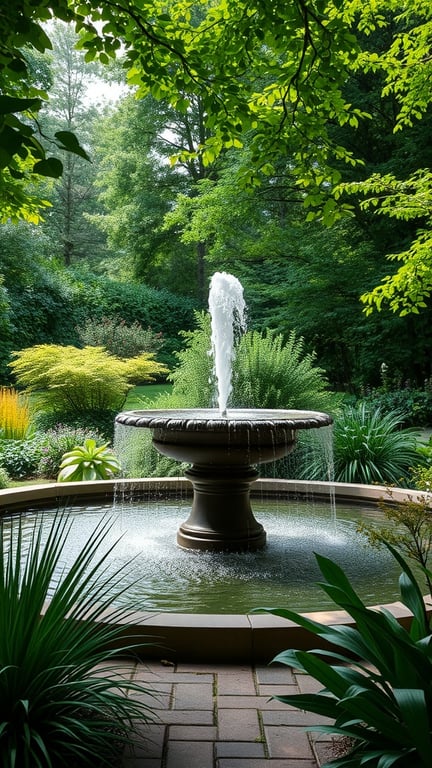
Shady gardens can be a challenge, but they also offer unique opportunities for creativity. One great way to enhance these spaces is by adding a focal point. In the image, you can see a beautiful fountain surrounded by lush greenery. This fountain serves as a stunning centerpiece, drawing the eye and creating a sense of tranquility.
Water features like this fountain not only add visual interest but also introduce soothing sounds. The gentle splash of water can make a shady garden feel more alive and inviting. Surrounding the fountain with a variety of plants adds depth and texture, making the area feel lush and vibrant.
When choosing a focal point, consider the style and size of your garden. A larger fountain can dominate a spacious area, while a smaller feature works well in more compact spaces. You can also think about incorporating colorful flowers or unique sculptures to complement the natural beauty of your garden.
Creating a focal point in shady areas can transform your garden into a peaceful retreat. It encourages relaxation and offers a perfect spot for enjoying nature. So, whether you opt for a fountain, a sculpture, or a cluster of colorful plants, make sure it stands out and enhances the beauty of your shady garden.
Creating a Cozy Seating Area
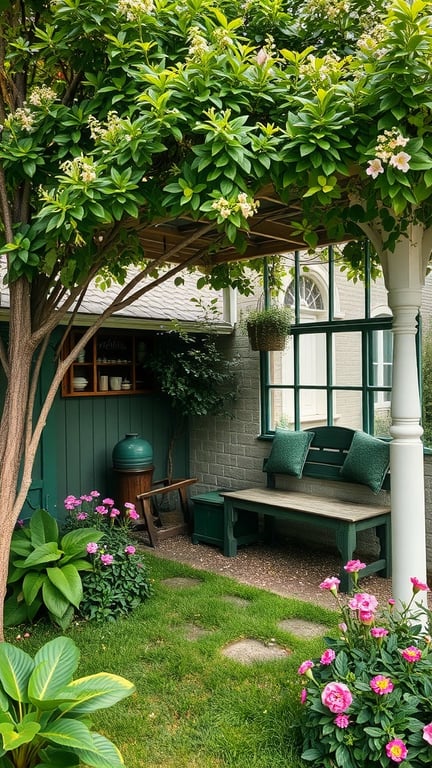
A cozy seating area can transform your shade garden into a welcoming retreat. Picture a charming nook surrounded by lush greenery and colorful blooms. The image shows a lovely bench nestled under a leafy canopy, perfect for relaxing with a book or enjoying a cup of tea.
The seating is simple yet inviting, with soft cushions that add comfort. Nearby, vibrant flowers bloom, adding pops of color to the space. This setup encourages you to unwind and soak in the beauty of nature.
Consider adding a small table for snacks or drinks. You might also want to hang some potted plants or lanterns for a touch of whimsy. The goal is to create a space where you can escape the hustle and bustle of daily life.
Incorporating natural elements like stone pathways or wooden accents can enhance the cozy vibe. This area can be a perfect spot for gatherings with friends or quiet moments alone. Embrace the tranquility that a shade garden offers and make it your special retreat.
Adding Vertical Elements for Depth
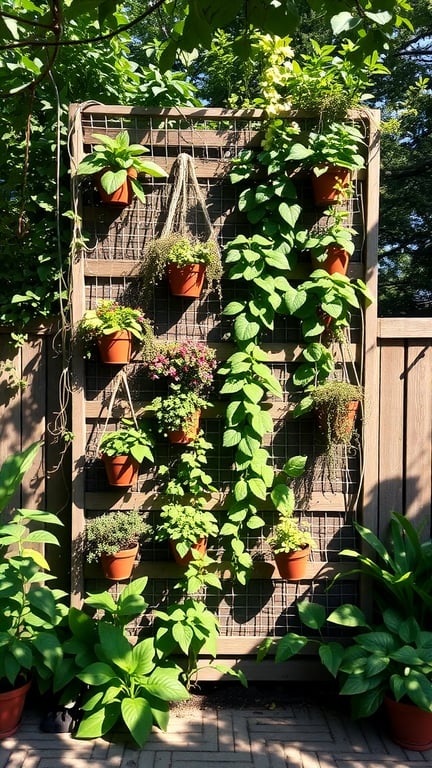
Vertical elements can truly transform a shade garden, adding depth and interest. The image shows a lovely vertical garden setup, featuring a wooden frame with various potted plants. This design not only saves space but also draws the eye upward, creating a more dynamic look.
Using a trellis or a similar structure allows you to showcase different plants at varying heights. In this case, trailing vines and colorful flowers hang gracefully, making the garden feel lush and inviting. The combination of greenery and blooms adds a splash of color, enhancing the overall aesthetic.
Incorporating vertical elements like this can also help manage light and create microclimates. Plants that thrive in shade can be placed strategically, ensuring they receive the right amount of light while still being part of a vibrant display. This setup encourages a sense of tranquility, perfect for a peaceful retreat.
Incorporating Ground Covers for Texture
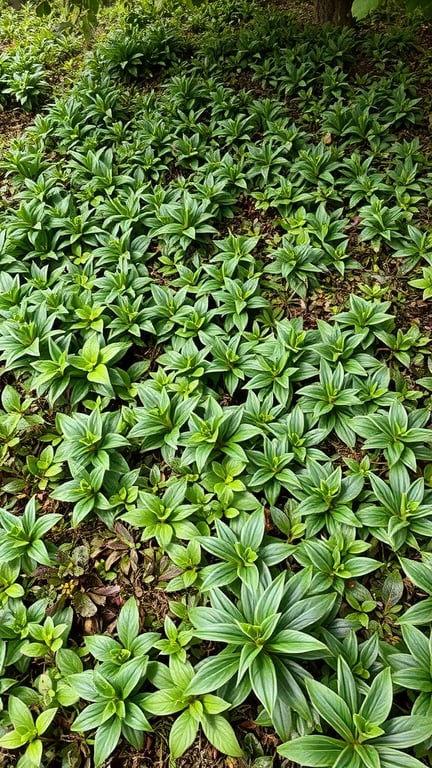
Ground covers are a fantastic way to add texture and depth to your shade garden. The image shows a lush carpet of green plants, creating a vibrant and inviting look. These plants not only fill in empty spaces but also help to suppress weeds, making maintenance easier.
Choosing the right ground covers can transform your garden. Look for varieties that thrive in low light and have interesting leaf shapes or colors. The plants in the image have broad, glossy leaves that catch the eye and create a rich, layered effect.
Mixing different types of ground covers can enhance the visual appeal. Consider combining plants with varying heights and textures. This approach adds dimension and keeps the garden looking lively throughout the seasons.
Ground covers also play a role in soil health. They help retain moisture and prevent erosion, making them a practical choice for shaded areas. Plus, they provide a soft surface for walking, making your garden more accessible.
Designing Pathways in a Shade Garden
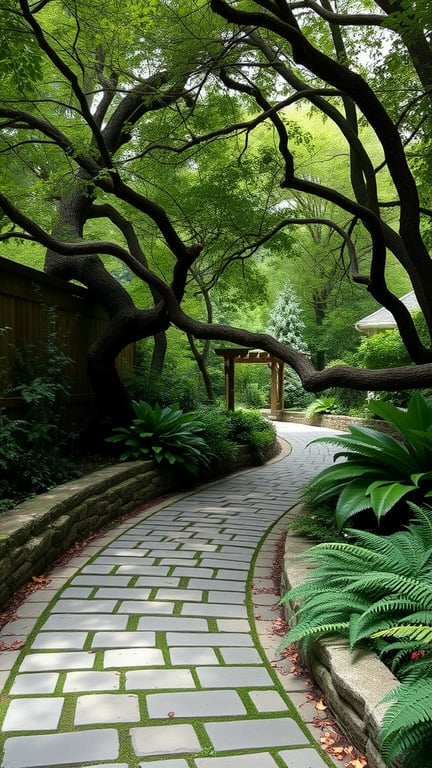
Creating pathways in a shade garden can transform the space into a welcoming retreat. The image shows a beautifully curved path, lined with lush greenery and shaded by overhanging branches. This design not only guides visitors through the garden but also invites them to explore its hidden corners.
Choosing the right materials for your pathways is key. In the image, the stone pavers blend seamlessly with the natural surroundings. They provide a sturdy surface while allowing for a bit of greenery to peek through, adding to the charm. Consider using materials that complement the plants and trees in your garden.
Curved paths, like the one shown, create a sense of movement and intrigue. They encourage a leisurely stroll, making the garden feel more expansive. You can incorporate gentle bends to lead the eye toward focal points, such as a bench or a sculpture, enhancing the overall experience.
Don’t forget about lighting! Soft, ambient lighting along the path can make evening strolls magical. It highlights the beauty of the plants and creates a cozy atmosphere. With thoughtful design, your shade garden can become a peaceful escape.
Using Color Palettes to Brighten Shade
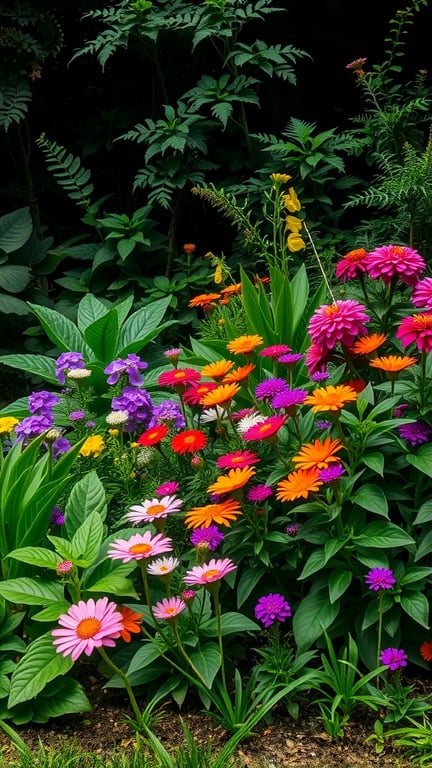
Shade gardens can often feel dark and dull, but with the right color palettes, they can burst with life. The image shows a vibrant collection of flowers in various shades, creating a lively scene against a backdrop of lush green foliage.
Bright colors like pinks, oranges, and purples stand out beautifully. These hues can transform a shady spot into a cheerful retreat. Mixing different flower types adds texture and depth, making the garden feel more dynamic.
Consider using complementary colors to create contrast. For example, pairing warm oranges with cool purples can make each flower pop. This approach not only brightens the space but also draws the eye, inviting exploration.
Don’t forget about foliage! Green leaves can enhance the colors of the flowers. Plants with variegated leaves can also add interest and break up the solid green.
Incorporating a variety of bloom times ensures that your garden remains colorful throughout the seasons. With careful planning, your shade garden can be a stunning display of color.
Choosing the Right Plants for Shade
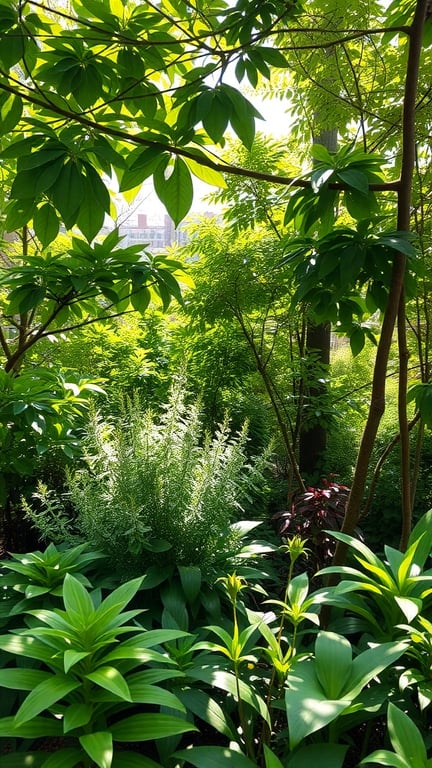
Creating a shade garden can be a delightful experience. The image showcases a lush green space filled with various plants that thrive in low light. The vibrant leaves and textures create a serene atmosphere, perfect for relaxation.
When selecting plants for shaded areas, it’s essential to consider their light requirements. Some plants, like hostas and ferns, flourish in these conditions. They add depth and interest to your garden. The greenery in the image highlights how different shades of green can work together beautifully.
Don’t forget about seasonal changes! Some plants may bloom in spring, while others provide year-round foliage. Mixing these varieties can keep your garden lively throughout the year. The image hints at this diversity, showing both leafy plants and those with unique shapes.
Lastly, think about the soil and moisture levels in your shade garden. Some plants prefer drier conditions, while others thrive in more moisture. Observing your garden’s environment will help you make the best choices. With the right plants, your shade garden can become a peaceful retreat.
Incorporating Water Features for Serenity
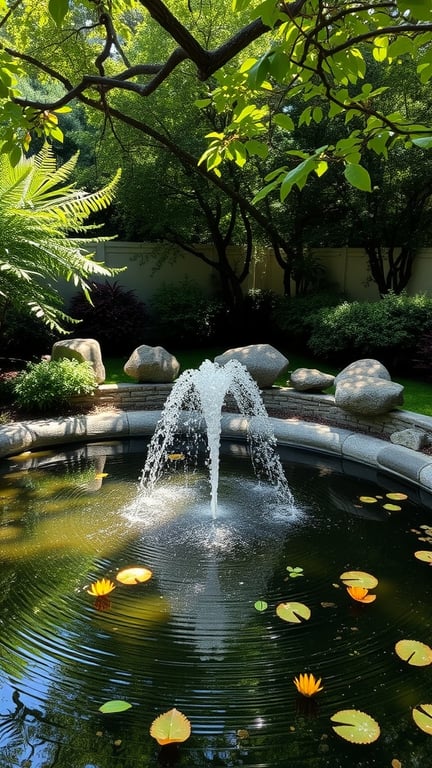
Water features can bring a sense of calm to any shade garden. The image shows a lovely pond with a fountain, surrounded by lush greenery. The gentle sound of water adds a soothing element, making it a perfect spot to relax.
The fountain in the center creates ripples in the water, which catch the light beautifully. This not only enhances the visual appeal but also attracts birds and other wildlife, adding life to your garden.
Surrounding the pond are smooth stones and vibrant water lilies, which contribute to the serene atmosphere. These elements work together to create a peaceful retreat where you can unwind and enjoy nature.
When planning your shade garden, think about how a water feature can fit in. It can be a small pond, a fountain, or even a simple birdbath. Each option can help create a tranquil space that invites relaxation and reflection.
Companion Planting for a Healthy Garden
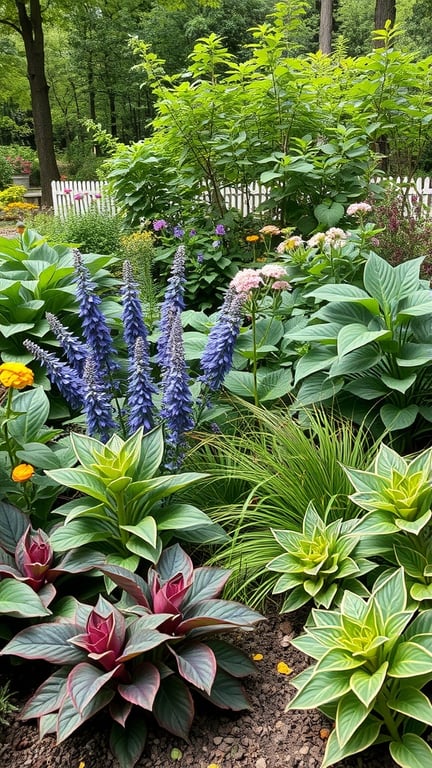
Companion planting is a fantastic way to create a thriving garden, especially in shaded areas. The image showcases a lush garden filled with various plants, each playing its part in the ecosystem. The vibrant blue flowers stand tall among the rich greens, while the colorful foliage adds depth and interest.
In a shade garden, choosing the right companions is key. For instance, hostas are great for ground cover, providing a beautiful backdrop for taller plants like the blue flowers. This not only enhances the visual appeal but also helps in moisture retention and weed suppression.
Mixing different plant types can also attract beneficial insects. Flowers like the pink ones in the image can draw pollinators, which is essential for a healthy garden. Pairing plants that complement each other in growth habits and nutrient needs can lead to a more balanced and productive garden.
Don’t forget about the soil! Healthy soil is the foundation of any garden. Adding organic matter and ensuring proper drainage will help all your plants thrive. With the right companions, your shade garden can flourish, offering a peaceful retreat filled with life and color.
Understanding Light Conditions in Shade Gardens

Shade gardens can be a delightful escape, filled with lush greenery and vibrant textures. The image shows a rich tapestry of plants thriving in a shaded area, highlighting how different light conditions affect plant growth.
The lush foliage in the picture reveals various shades of green, indicating the diversity of plants that can flourish in low-light environments. From ferns to leafy plants, each species adapts uniquely to the available light.
The inset chart at the bottom illustrates light conditions, helping gardeners understand how to categorize their space. This visual guide can assist in selecting the right plants for different levels of shade, ensuring a thriving garden.
Creating a shade garden is about knowing your light. Some areas may receive dappled sunlight, while others might be in deep shade. Understanding these nuances can lead to a successful garden filled with life.
Caring for Shade Plants: Watering and Fertilizing
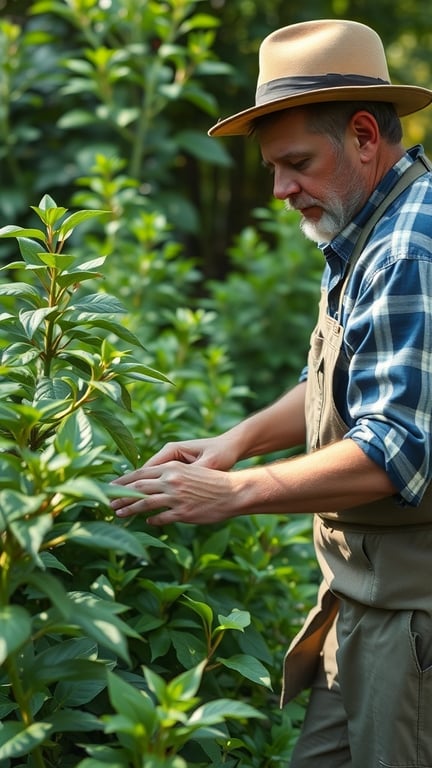
In a cozy shade garden, a gardener is seen watering plants, showcasing the importance of proper care for shade-loving plants. The lush greenery surrounding him highlights the beauty of these plants thriving in low-light conditions.
Watering is essential for shade plants, as they often require consistent moisture. It’s best to check the soil regularly. If the top inch feels dry, it’s time to water. Use a gentle spray to avoid disturbing the soil too much.
Fertilizing shade plants can be a bit different. They usually benefit from a balanced, slow-release fertilizer. Applying it in early spring can help them grow strong throughout the season. Just be careful not to over-fertilize, as this can harm the plants.
Observing your plants will give you clues about their needs. Yellowing leaves might indicate too much water, while wilting could mean they need more. With a little attention, your shade garden can flourish beautifully.
Wildlife-Friendly Shade Gardens

Creating a wildlife-friendly shade garden is a wonderful way to support local ecosystems. The image shows a lush garden filled with various plants, providing a perfect habitat for birds and insects. The greenery is vibrant, showcasing a mix of textures and shapes that invite wildlife to thrive.
In this garden, the stone path leads through a rich tapestry of foliage. The plants are carefully chosen to flourish in low light, ensuring that even shaded areas come alive with life. This not only enhances the beauty of the space but also attracts beneficial creatures.
Bird feeders, like the one hanging in the tree, can be a great addition. They offer a reliable food source for birds, encouraging them to visit and make your garden their home. Incorporating native plants is also key, as they provide the right environment for local wildlife.
Creating a wildlife-friendly space doesn’t have to be complicated. Start with a few plants that thrive in shade and watch how quickly nature responds. With a little patience, your garden can become a sanctuary for both you and the creatures that share it.
Seasonal Interest in Shade Gardens
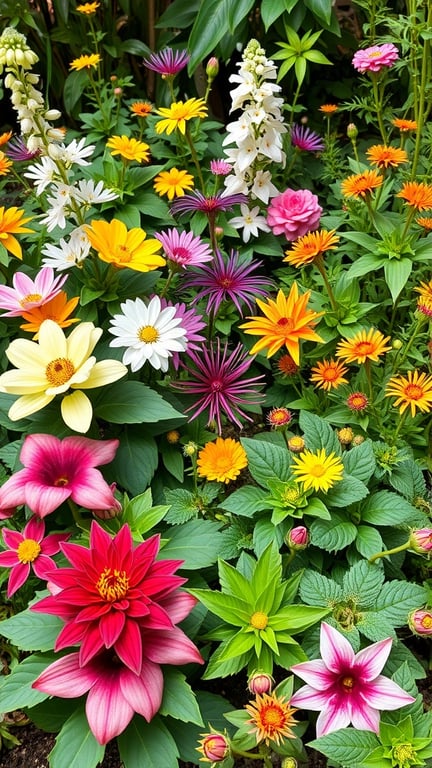
Shade gardens can be a vibrant and lively part of your outdoor space. The image showcases a delightful mix of flowers that thrive in lower light conditions. You can see bright pinks, yellows, and whites, all coming together to create a cheerful display.
Each flower adds its unique charm. For instance, the tall spikes of the foxglove stand proudly among the shorter blooms, creating layers of color and texture. Sunflowers and echinacea bring a sunny feel, even in the shade, while the delicate petals of the pink flowers soften the overall look.
Seasonal interest is key in a shade garden. Choosing plants that bloom at different times ensures there’s always something to admire. The combination of annuals and perennials can keep your garden lively throughout the year. Think about adding some foliage plants too, as they provide structure and color even when flowers fade.
Incorporating a variety of plants not only enhances visual appeal but also supports local wildlife. Bees and butterflies love these flowers, making your garden a haven for pollinators. So, whether you’re sipping coffee on your porch or hosting a garden party, your shade garden can be a beautiful backdrop.
Choosing the Right Mulch for Moisture Retention
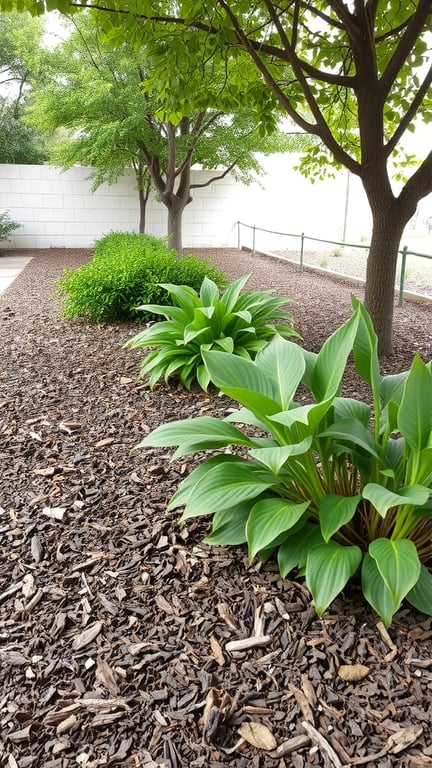
When creating a shade garden, selecting the right mulch is key. The image shows a lovely garden area with lush green plants surrounded by a layer of mulch. This setup not only looks good but also plays an important role in moisture retention.
Mulch acts as a protective barrier for the soil. It helps keep the moisture in, especially in shaded areas where evaporation is slower. The brown color of the mulch in the image contrasts beautifully with the vibrant greens of the plants, enhancing the garden’s overall appeal.
Organic mulches, like wood chips or bark, break down over time, enriching the soil. They also provide a natural look that blends well with the surroundings. In the image, the mulch is spread evenly, creating a tidy and well-maintained appearance.
Choosing the right mulch can also help suppress weeds. With less competition for nutrients and water, your plants can thrive. In this garden, the mulch not only retains moisture but also keeps weeds at bay, allowing the hostas and other plants to flourish.
In summary, the right mulch can make a big difference in a shade garden. It helps maintain moisture, enhances the beauty of the space, and supports healthy plant growth. So, when planning your garden, don’t overlook this simple yet effective element!
